Greatest Completed Work of Art Only Compared to the Sistine Chapel
There's nothing similar Michelangelo'south world-famous frescoes in the Sistine Chapel. Just as special every bit the Sistine Chapel is, it isn't the simply architectural infinite in Italy where you can discover jaw-droppingly vibrant, detailed, and beautiful, not to mention art-history-irresolute, frescoes.
Here are some of our favorite spaces in Italian republic to add to your list (some even influenced Michelangelo himself!). Bonus: Each of them is in a town that's well worth a visit in its ain right.
Note: When visiting these incredible spaces, just think that what damages fresco more than anything else is moisture and humidity! So don't stand too shut to the art (your breath actually does make a difference!), and please, never, ever touch on the artwork. That manner, your children and their children will be able to savor these beautiful masterpieces, as well!
Scrovegni Chapel, Padua
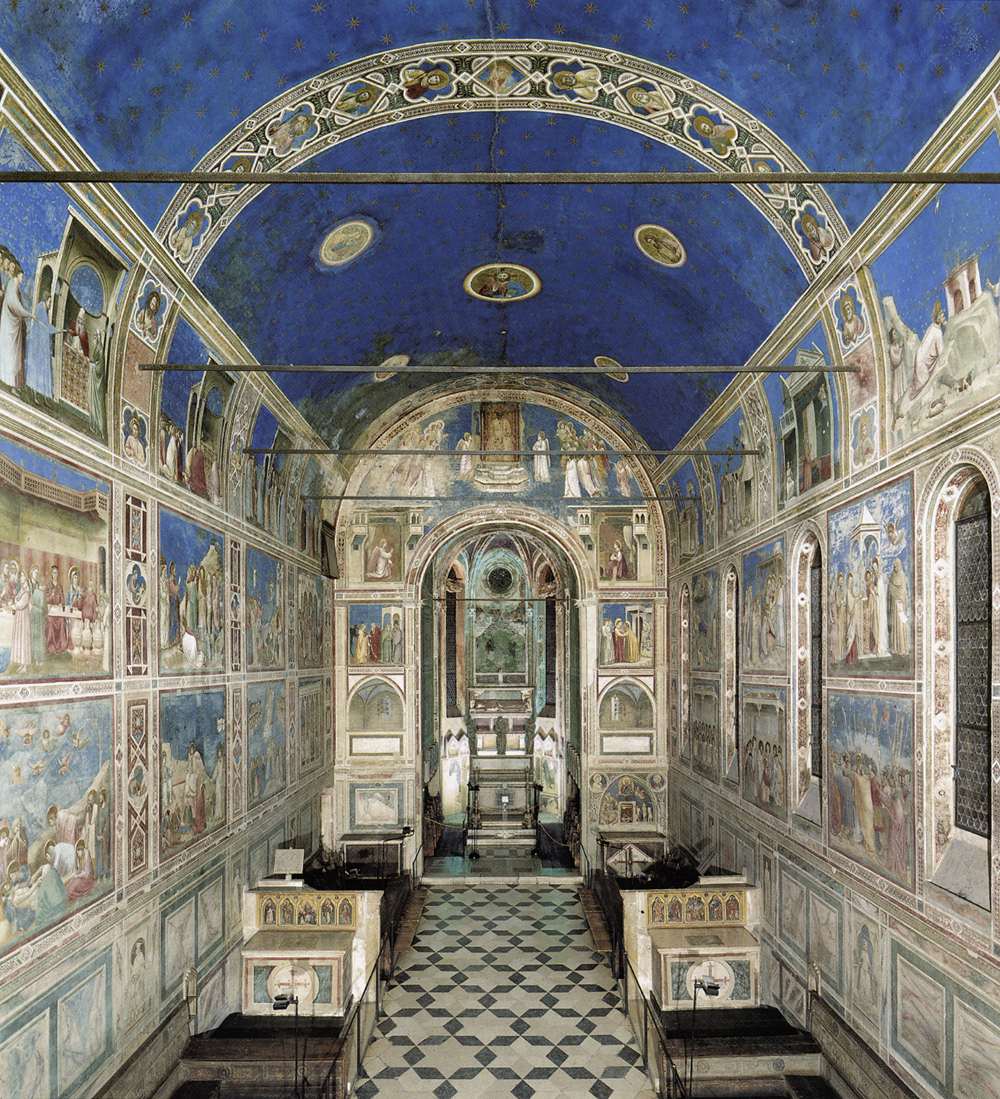
Giotto had to be creative to overcome the obstacles acquired by the chapel's architecture — yous can even see how he extended the wall paintings upwardly into the ceiling to attempt to rest information technology all!
Located an piece of cake 25- or 45-minute railroad train ride from Venice, Padua has a lot to boast about: mythical ties to the city of Troy, the 2d-oldest university in Italy (and 1 where Galileo taught)… and an incredible 14th-century chapel that's ane of Italian republic'south top sites for pilgrims. Fine art history pilgrims, that is.
The chapel was built past Enrico Scrovegni in 1302, after his begetter'due south practice of lending out money at super-high interest rates — something seen as so sinful, it landed the man in Dante'southward Inferno — filled him with such guilt he built a chapel with the family's earnings. (He dedicated it to to the "Virgin of Charity").
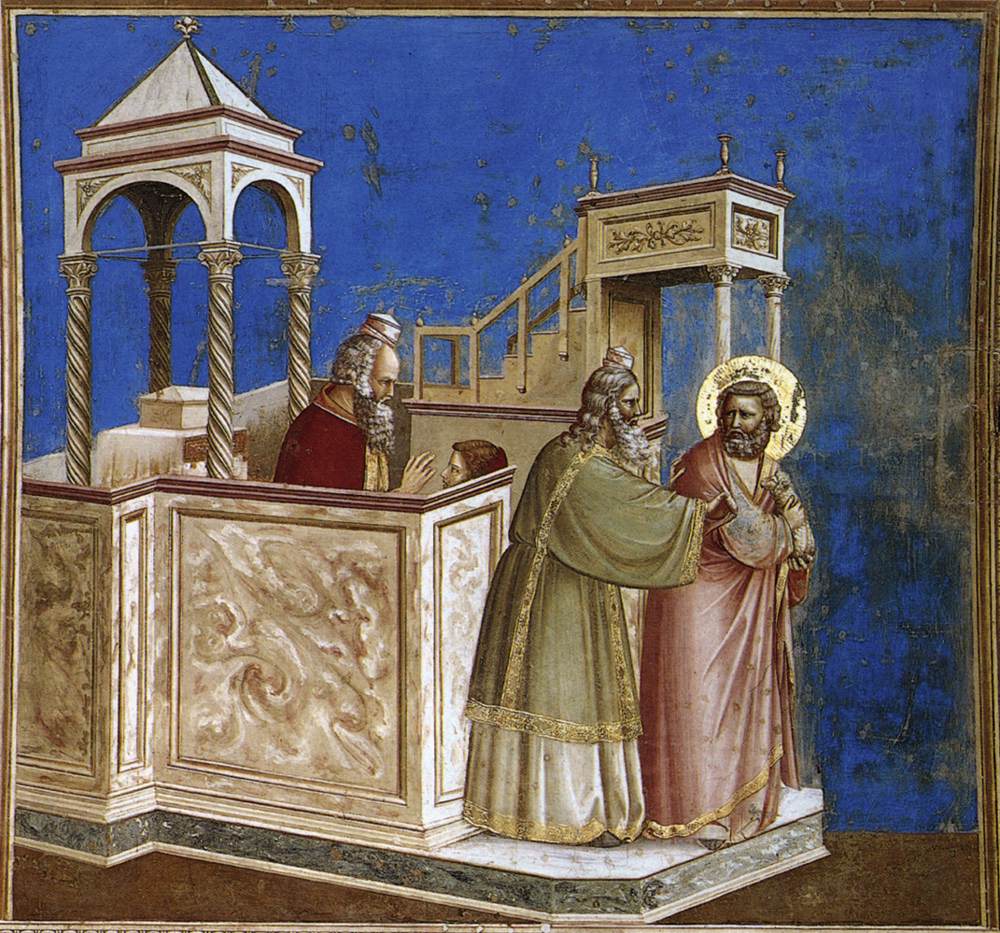
The space on the right, planned that way by Giotto, makes information technology look like poor Joachim is being thrust into an empty, lonely abyss
Scrovegni deputed the Florentine painter Giotto for the frescoes. The result is the earliest work that's accepted every bit existence by Giotto's own mitt. For art historians, that means information technology's the keystone for deciding if later pieces (like those in the Basilica of San Francesco, below) were by Giotto, also. Like Michelangelo more than than two centuries later, Giotto had to grapple with how to lay his fresco cycle out on a barrel-vaulted building. And, like Michelangelo, it'south off-white to say he did, well, a pretty good chore!
The whole story of the New Testament is laid out here, starting with the heartbreaking Expulsion of Joachim from the Temple. The panel shows Joachim, the Virgin's father, being literally pushed out of the temple past a priest, Joachim's offering rejected because he remains childless; the anguish on Joachim's face is palpable.
The narrative continues through to Christ's life, with the famous frescoes of the Lamentation and Osculation of Judas.
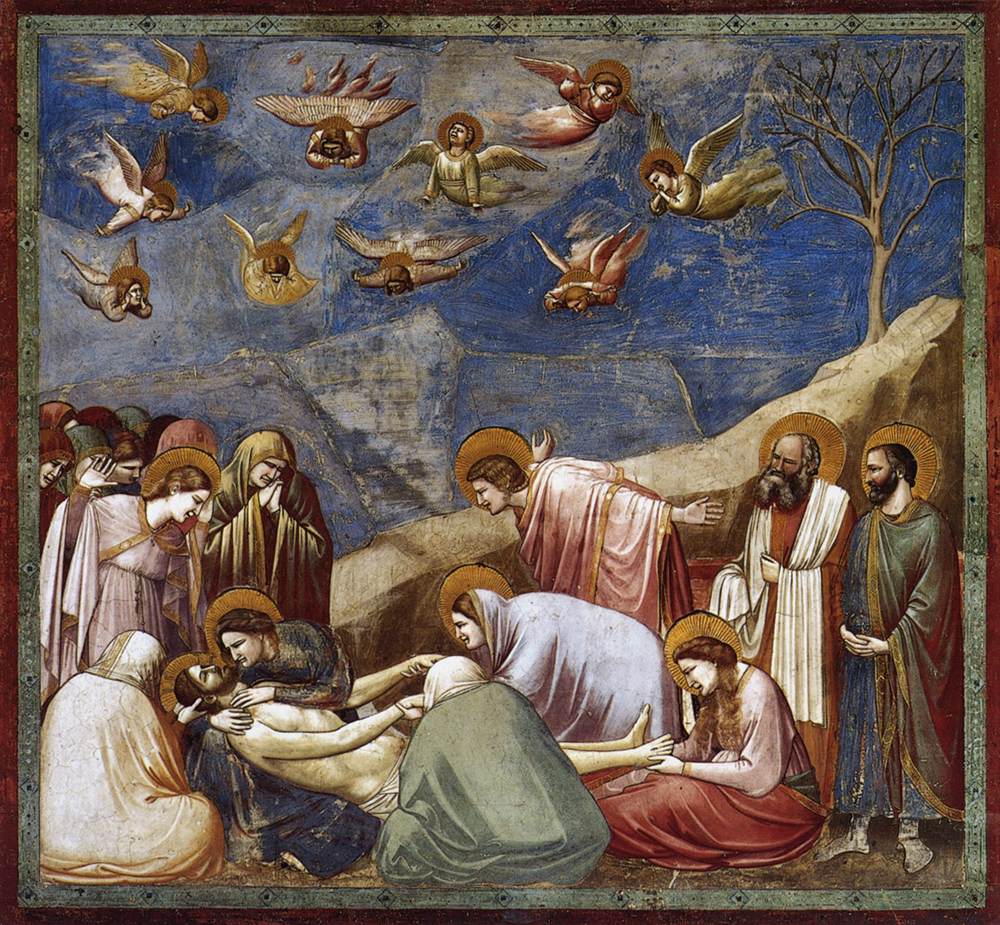
Giotto was a master of emotion — just expect at the anguish on Mary's confront
Don't miss the Final Judgment, either, a fantasy of all the horrific tortures that await the damned. Few paintings in art history could be more frightening! This was i piece that influenced Michelangelo for his own version of the Last Judgment.
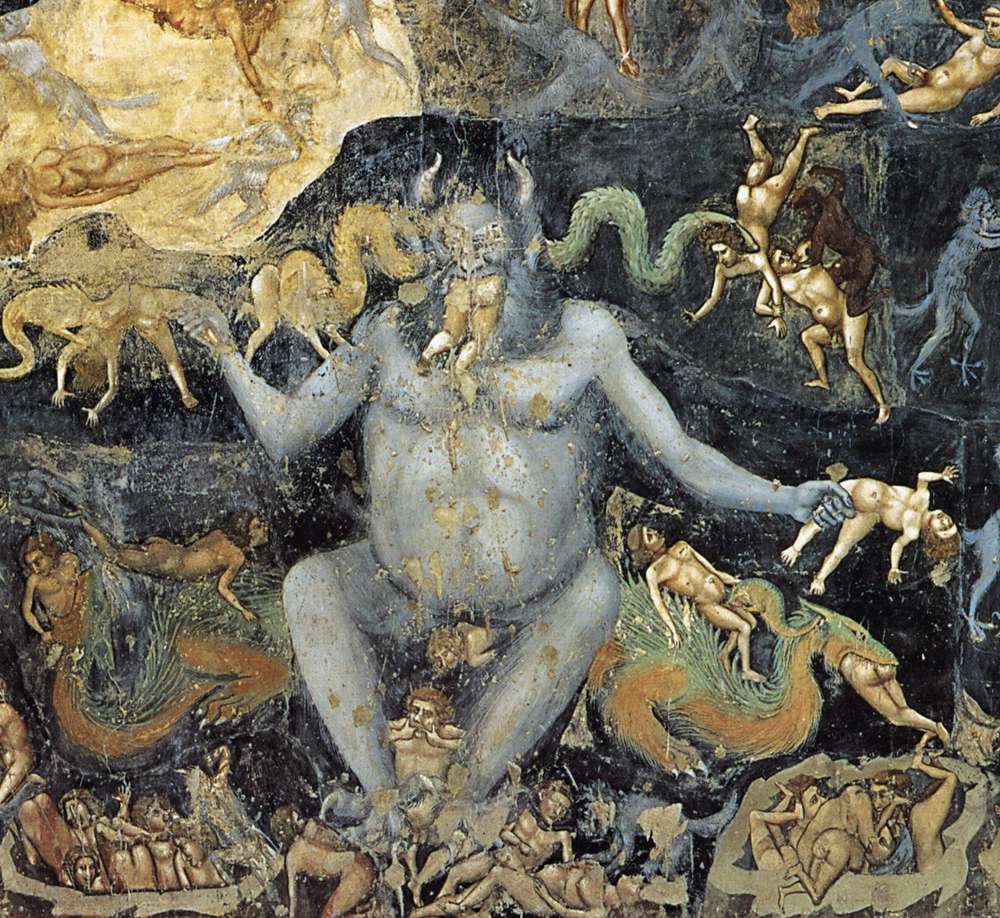
A detail of Giotto'due south Last Judgment, complete with a monster eating the damned. Eek!
In all of the frescoes, you can see just why Giotto was so groundbreaking, he's known as one of the fathers of the Renaissance. Giotto's use of space and volume, and his two-point perspective scheme (which unites both painting and architecture in the catchy-to-paint chapel), show an agreement of perspective that heralded the showtime of the Renaissance.
Information technology'southward the emotion of the figures, though, that really set Giotto apart, making him one of the merely artists of his solar day who knew how to paint saints to await and interact similar real people. And, almost 800 years later, Giotto's ability to invoke emotion still takes your breath abroad.
Piccolomini Library, Siena
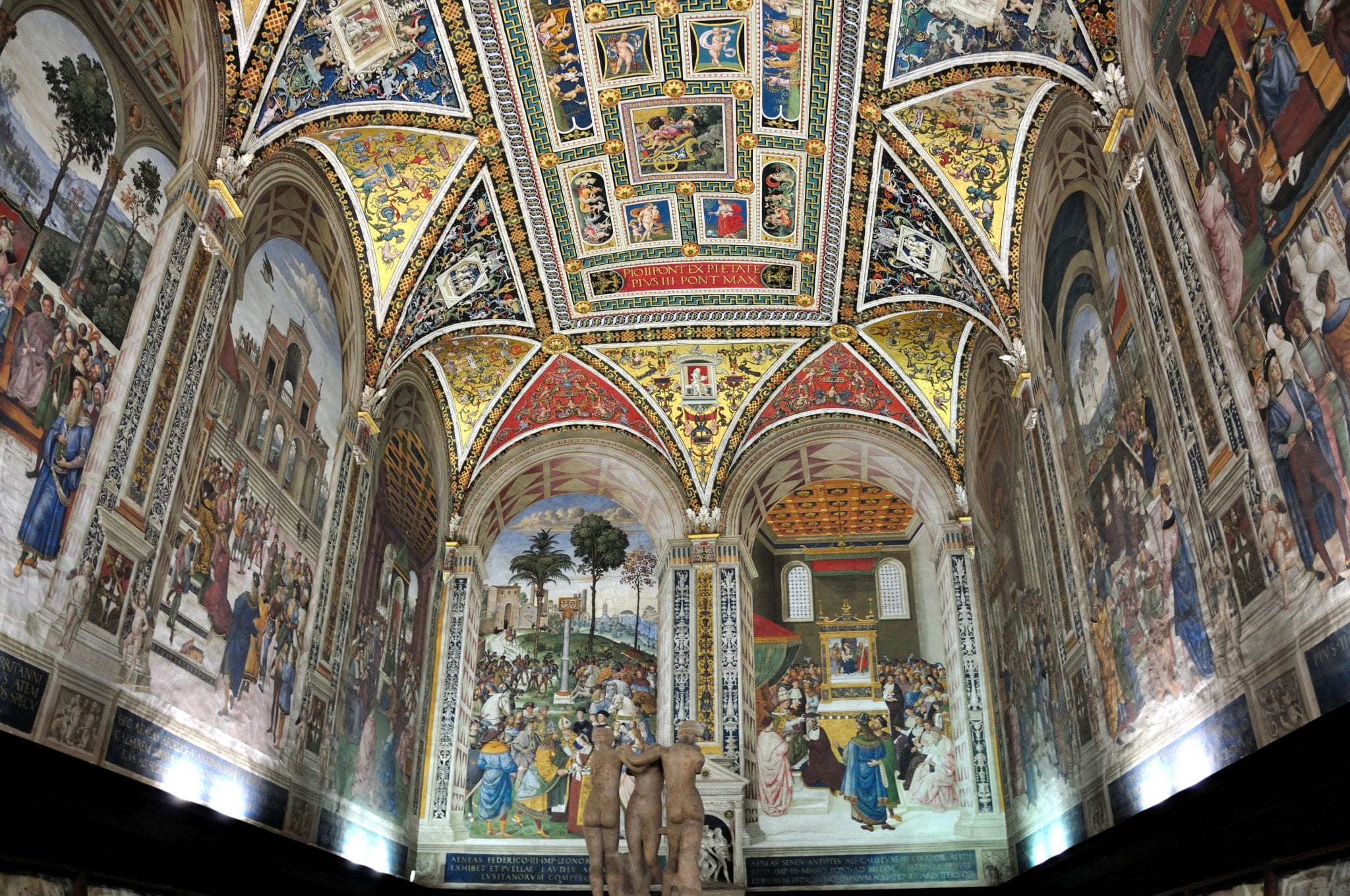
Piccolomini Library in Duomo of Siena
The Duomo of Siena is one of our favorite churches in Italia. But hidden within the gorgeous, elaborate space is another gem: the Piccolomini Library.
Similar the Sistine Chapel, the library's frescoes are, more or less, a family's celebration of… itself. After all, Pope Julius 2 commissioned Michelangelo to glorify the chapel built by his uncle, Pope Sixtus 4. Similarly, in 1502, the famous painter Pinturicchio was commissioned by Francesco Todeschini to paint panels of the life of Pope Pius 2.
After all, Pope Pius Ii was Todeschini's uncle — and he'd raised Todeschini to the rank of cardinal in 1460. Todeschini himself became pope in 1503, taking the proper name Pius Three… simply he died just 26 days later. (The next pope? Julius II!).
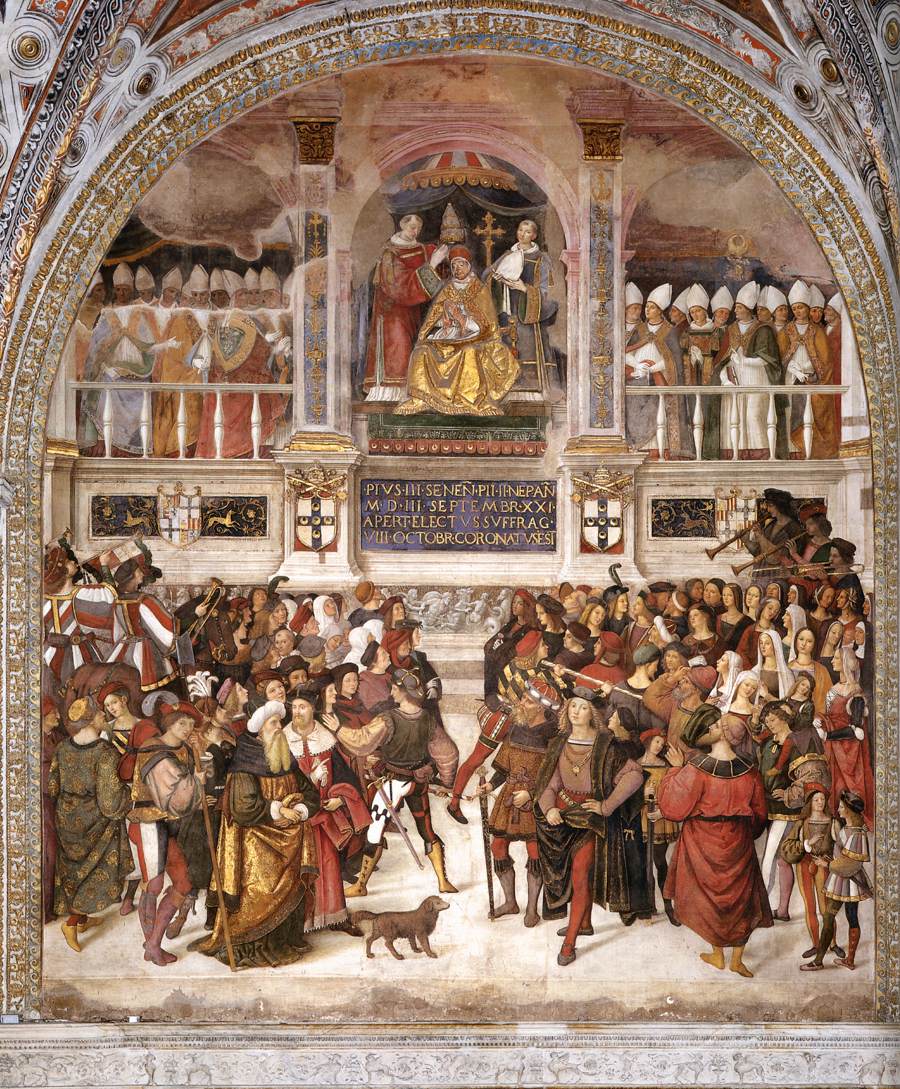
Scene of the coronation of Pope Pius III himself, in Pinturrichio'southward Piccolomini Library
The x episodes from Pius' life are done with boggling realism, clarity, item, and color, and thanks to a recent restoration, they're especially vibrant. As if those frescoes weren't incredible enough, even the ceiling is covered in paintings with gold foliage accents.
Although information technology's easy to get caught up in all the gorgeous painting, don't miss the books that requite the Piccolomini Library its official purpose. These precious, illuminated manuscripts belonged to Pope Pius 2, who was known for his humanism and his learnedness.
Siena is a one.five hr train ride from Florence. A precious stone of a medieval urban center, and in one case Florence's main rival, it's also the domicile of the famous Palio races.
Camera degli Sposi, Mantua
The Photographic camera degli Sposi is a room entirely covered with frescoes painted by Mantua's artist-in-residence Andrea Mantegna, who spent 46 years of his life in the town serving Ludovico Gonzaga and his successors. Located in the Palazzo Ducale, the 500-room behemoth that served as the Gonzaga Family unit Palace, the 15th-century frescoes depict members of the powerful Gonzaga Family. In particular, the "meeting scene" and the "court scene," each celebrating the power and prestige of the Gonzaga's and Mantua itself.
A relatively small room in the north tower of the palace, Mantegna'south fresco paintings completely transformed the space with color and perspective. Using thetrompe fifty'oeil painting technique, the well-nigh striking characteristic seems to be the room's ceiling and the sky painted on the center of it, creating the illusion that the room extends on forever. Originally called the Camera Picta, or painted room, the romantic name ofPhotographic camera degli Sposi (wedding bedroom or conjugal sleeping accommodation in English) is likely an allusion to the repeated presence of Ludovico and his helpmate on the walls, and not a suggestion that the room was actually used equally a wedding ceremony chamber.
With internal courtyards, frescoes, world-class fine art and incredible mosaics, there's plenty to see inside Palazzo Ducale, but the biggest draw is past far the intricate frescoes in the Camera degli Sposi.
Chapel of San Brizio, Orvieto
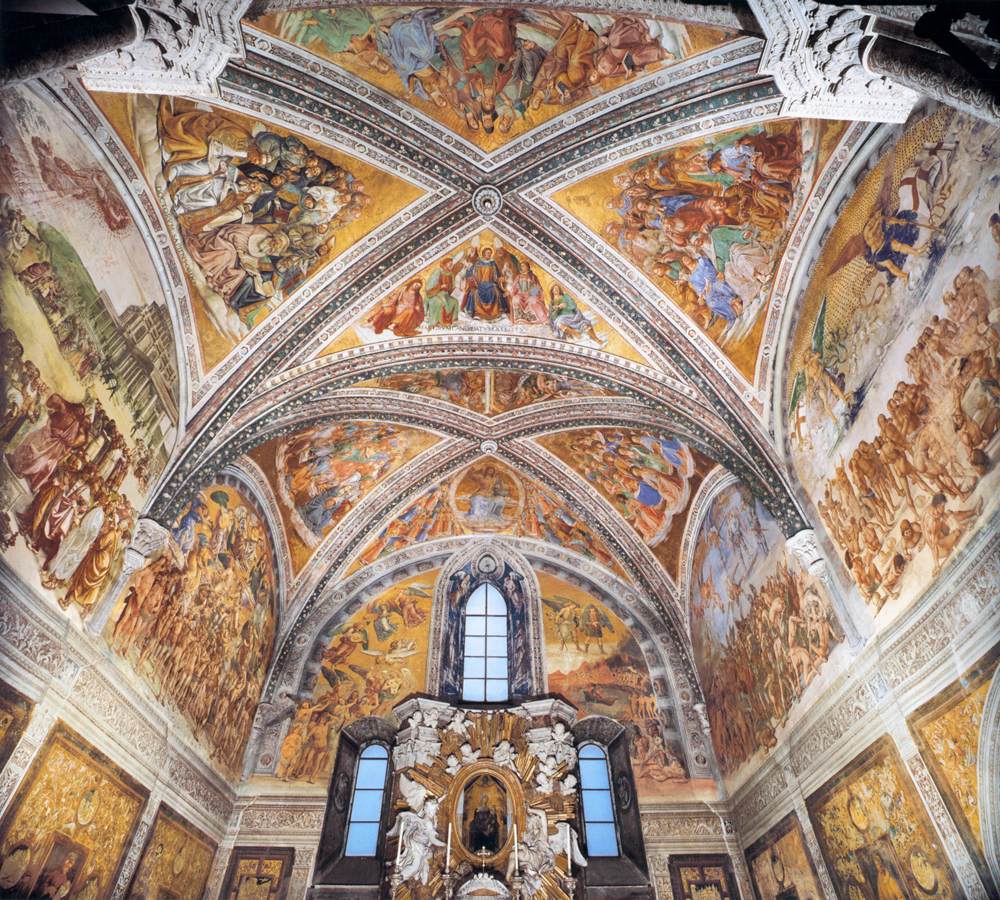
Signorelli's frescoes here laid the groundwork for Michelangelo'southward Last Judgment
Earlier Michelangelo's Last Judgment in the Sistine Chapel, there was Luca Signorelli's masterpiece: the Chapel of San Brizio frescoes in the Duomo of Orvieto.
Signorelli started his work in the Duomo of Orvieto in 1499. Tuscan in origin, similar Michelangelo, he'd already painted in the Sistine Chapel himself, being responsible for the Testament and Death of Moses on the side wall. What Signorelli did with the Chapel of San Brizio, though, made the fresco cycle 1 of the most influential works of art in Italy.
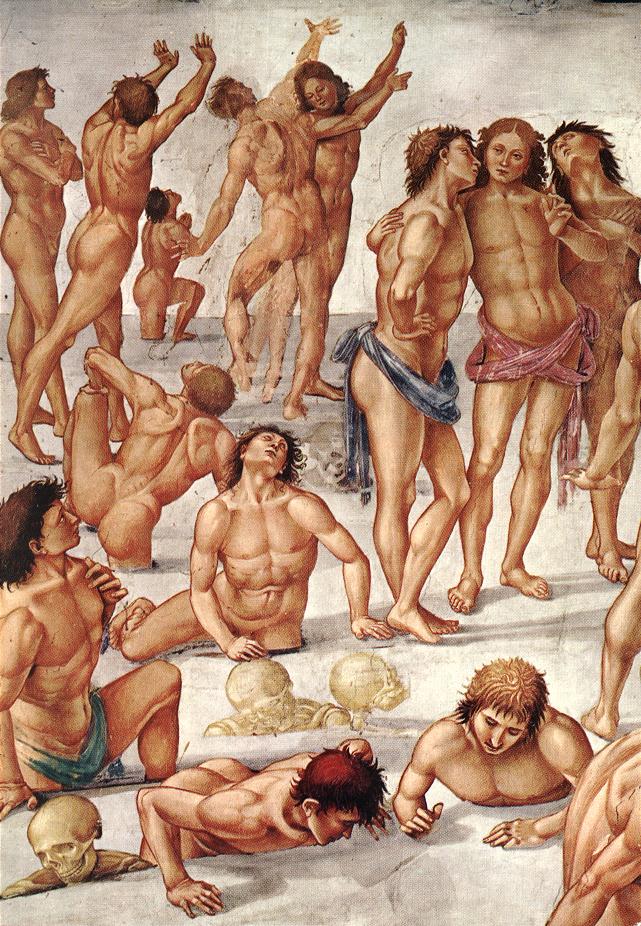
Those muscled bodies, hauling themselves out of the world, showed up again 35 years later… in Michelangelo's Final Judgment
Information technology was besides ane of the nigh influential works of art on Michelangelo, who studied Signorelli's work earlier he started his own Concluding Judgment in 1535. And it'south safe to say that without Signorelli'south incredible compositions of muscled men hauling themselves out of the world for the Resurrection, or gruesome tortures being administered to the damned, Michelangelo would have wound up with a much dissimilar Concluding Judgment than the one we run across today.
Ane of the virtually striking things about Signorelli's frescoes are just how, well, new they seem — and non only because they're so bright and vibrant. All twisted postures, exaggerated muscles, and crazy color schemes (like the purple, greenish, and blue-colored demons in the scene of the damned), they await like something out of a comic book or even a video game. To 16th-century viewers, though, the scenes would accept seemed much more real, showing them exactly what they could expect on the mean solar day of judgment… and how their sins today would take terrifying consequences tomorrow.
Whether you want to see where Michelangelo got his inspiration, or simply lose yourself in these crazy, colorful scenes of the afterlife, don't miss the Chapel of San Brizio. Y'all can go to Orvieto from Rome on the train in 45 minutes, and, given its beauty and sites of involvement, nosotros remember information technology'southward one of the best mean solar day-trip options from Italy'southward capital city.
The House of Augustus and Livia
Emperor Caesar Augustus' palace on the Palatine Colina is considered one of the world'due south virtually significant houses. Considered the perfect instance of private art and ornamentation of the time, overall the house was quite a humble home, past the standards of the day.
Augustus' own house was quite small and devoid of marble, and the emperor was known for sleeping each dark in minor, spartan quarters. His second wife, Livia, lived in slightly larger, slightly more than opulent apartments, with marble floors and pillars. Both of the houses are well-nigh perfectly preserved: visiting them it feels equally if the inhabitants have simply stepped out for the afternoon and will soon return home to resume life as normal.
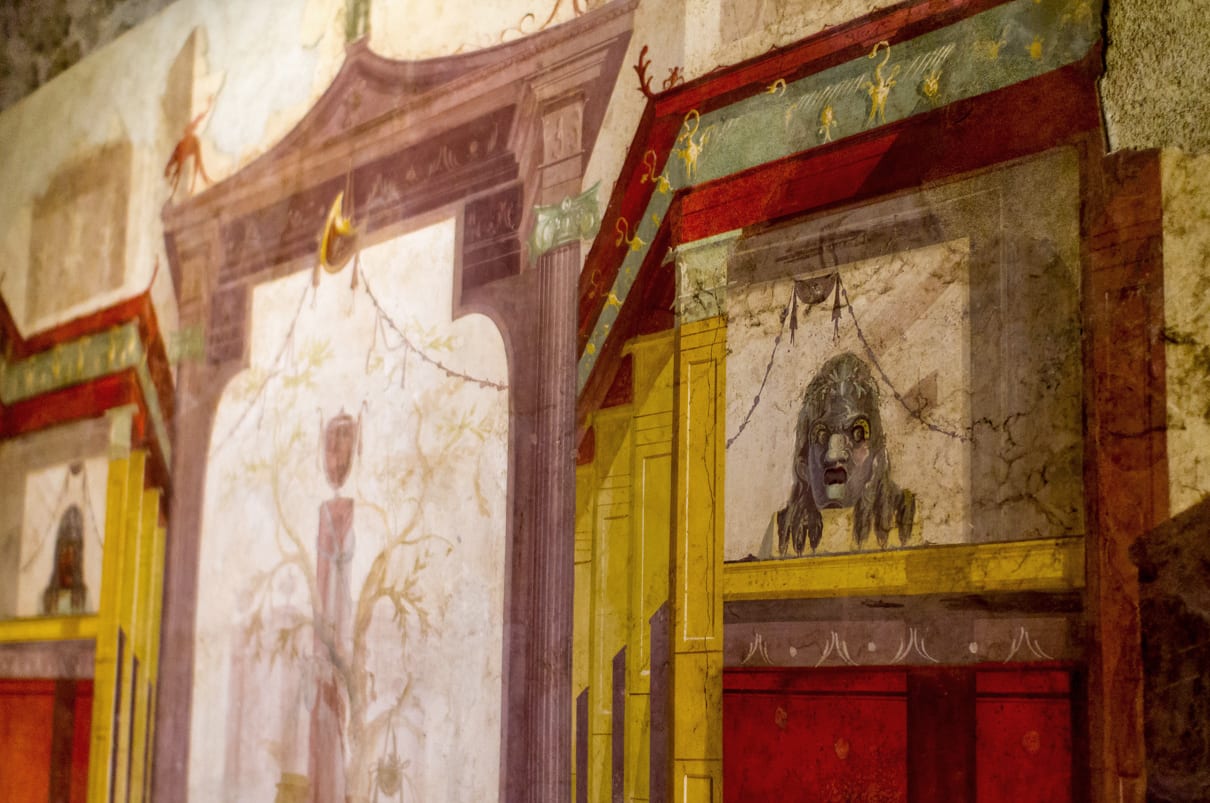
The 'Room of the Masks' in The House of Augustus.
One area where Augustus didn't follow his humble design themes was in the artwork. The best painters of the day frescoed gorgeous scenes of theaters and countrysides along the ceiling and walls, particularly in the Palace's w wing. One room, the "Room of Masks", has a theater scene painted on the walls, with masks painted on the frame around information technology. The other is painted with garlands of pine needles hanging among thin pillars.
Though the frescoes cracked and savage over time, archeologists were able to collect them, clean them off, and put them back together on the walls, piece by slice.
Visiting his firm (which you can only practice on a guided tour) offers the chance to experience these paintings simply equally Augustus did over 2,000 years ago, giving visitors an intimate expect at the not bad man'southward private life and a unique insight into a listen that was as ruthless and cunning as it was fair and orderly.
Bring together us and our expert local guide on a walk that takes yous to the heart of Ancient Rome (usually every bit function of the Colosseum, Roman Forum, and Palatine Colina tour).
The Terminal Supper, Milan
If there is i other fresco as highly celebrated as the Sistine Chapel, it's Leonardo da Vinci's Final Supper in Milan's Santa Maria delle Grazie Cathedral.
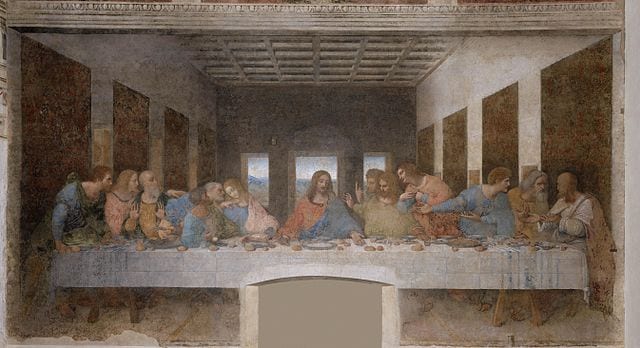
Public Domain version of Leonardo da Vinci's Terminal Supper. Photo from Wikicommons
For an extensive guide on how to come across da Vinci'south Final Supper check out our blog post.
The enormous painting (it's 15 feet by 29 feet) depicts the moment right later Jesus declares to his twelve apostles that one of them will betray him – right down to the individual expressions on each apostle's confront! Though a Renaissance masterpiece, we take to be honest, the Final Suppertechnicallyisn't a fresco.
Da Vinci'southward notoriously slow painting methods didn't pair well with the fresco style of painting on moisture plaster – he couldn't finish before the plaster stale! To business relationship for this, Da Vinci painted directly on drywall, finer inventing a new painting technique chosenfresco secco, or dry fresco.
Though it allowed him to paint within his own time limits, it also meant that the painting began deteriorating almost equally soon equally it was painted. Still, there's no uncertainty that this "not-fresco" is one of the most admired, historic "frescoes" in all of Italy.
No trip to Milan is consummate without visiting Leonardo Da Vinci'due south Concluding Supper. This masterpiece draws thousands of visitors each year to see the jaw-dropping detail of this masterpiece in person. Admiring this masterpiece is a unique experience…but information technology's non something you can do last-minute! The easiest and more informative way to see it is with our small-grouping tours led past an expert guide.Thousands of visitors each year come to come across in person the jaw-dropping detail of this masterpiece.
Read more: A Fine Line: Restoring Leonardo da Vinci'south The Concluding Supper
Basilica of San Francesco, Assisi
Built in honor of St. Francis in the 1220s, the Basilica of San Francesco is one of the nearly cute, and of import, churches in Italy. The basilica was, like the Sistine Chapel 260 years subsequently, designed to be simple, architecturally-speaking — all the better for covering with frescoes. And that's exactly what happened.

Information technology's hard to grasp the scale of just how large the Basilica of St. Francis is — until you lot look at the size of the pews!
In the upper role of the two-level basilica, the walls are covered in vibrant frescoes from floor to soaring ceiling. Everywhere you lot look, you see color, light, and space — an extraordinary feeling.
Similar all the best Renaissance frescoes, though, each of these have a story to tell. The 32 scenes running along the top of each side of the nave describe stories from the Old and New Testaments; information technology'south idea that the famed Roman master Pietro Cavallini may accept been involved. Below, 28 dissimilar panels show scenes from St. Francis' life (don't miss him speaking with the birds!), often attributed, although controversially, to Giotto.

The Upper Church's fresco of the Renunciation of Worldly Goods, probable by Giotto, shows the space, iii-dimensionality, and movement that Giotto was and so famous for
The frescoes in the apse and transept are past Cimabue, another of Italy's about important early Renaissance painters. Perhaps the virtually striking is as well the about mysterious: Cimabue'south Crucifixion panel has, over time, turned into a negative of itself, with the low-cal colors condign dark and dark becoming light, through chemic processes that remain unexplained.

Over fourth dimension, Cimabue'due south Crucifixion, painted in nearly 1280, became a negative of itself!
The Lower Basilica is only as stunning, although completely dissimilar. It'southward lined with a series of dimly-lit, ornately-decorated chapels. The ceiling in a higher place the high altar is covered in gold-laden frescoes, including allegories of Obedience, Poverty and Chastity by i of Giotto'due south pupils. On the transept wall is Cimabue's well-nigh famous masterpiece, Our Lady Enthroned and St. Francis, in 1280; Giotto and his workshop did the frescoes of Christ's childhood in the right transept.
Then, of course, there'south the tomb of St. Francis himself, another level below in an eerie crypt, usually filled with pilgrims praying as they perambulate effectually his tomb.
Assisi, a gorgeous town and worth visiting in its own right (believe it or not, it boasts even more than the Basilica!), is a 2-hour train ride from either Rome or Florence.
You might too like:
The 10 Best Things to practice in Vatican City
In Photos: & Places to See the Best Byzantine Mosaics in Italia
Source: https://www.walksofitaly.com/blog/art-culture/renaissance-frescoes-in-italy-beyond-michelangelo-sistine-chapel